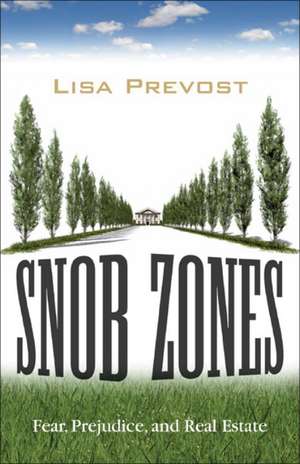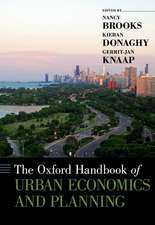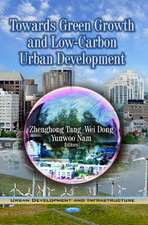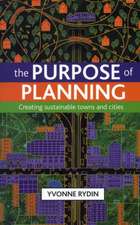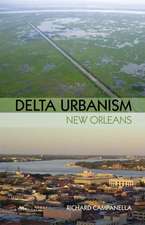Snob Zones: Fear, Prejudice, and Real Estate
Autor Lisa Prevosten Limba Engleză Hardback – 6 mai 2013
Towns with strict zoning are the best towns, aren't they? They're all about preserving local "character," protecting the natural environment, an dmaintaining attractive neighborhoods. Right?
In this bold challenge to conventional wisdom, Lisa Prevost strips away the quaint façades of these desirable towns to reveal the uglier impulses behind their proud allegiance to local control. These eye-opening stories illustrate the outrageous lengths to which town leaders and affluent residents will go to prohibit housing that might attract the “wrong” sort of people. Prevost takes readers to a rural second-home community that is so restrictive that its celebrity residents may soon outnumber its children, to a struggling fishing village as it rises up against farmworker housing open to Latino immigrants, and to a northern lake community that brazenly deems itself out of bounds to apartment dwellers. From the blueberry barrens of Down East to the Gold Coast of Connecticut, these stories show how communities have seemingly cast aside the all-American credo of “opportunity for all” in favor of “I was here first.”
Prevost links this “every town for itself” mentality to a host of regional afflictions, including a shrinking population of young adults, ugly sprawl, unbearable highway congestion, and widening disparities in income and educational achievement. Snob Zones warns that this pattern of exclusion is unsustainable and raises thought-provoking questions about what it means to be a community in post-recession America.
Preț: 135.21 lei
Nou
Puncte Express: 203
Preț estimativ în valută:
25.88€ • 26.62$ • 21.47£
25.88€ • 26.62$ • 21.47£
Carte indisponibilă temporar
Doresc să fiu notificat când acest titlu va fi disponibil:
Se trimite...
Preluare comenzi: 021 569.72.76
Specificații
ISBN-13: 9780807001578
ISBN-10: 0807001570
Pagini: 192
Dimensiuni: 150 x 221 x 20 mm
Greutate: 0.32 kg
Editura: Beacon Press (MA)
ISBN-10: 0807001570
Pagini: 192
Dimensiuni: 150 x 221 x 20 mm
Greutate: 0.32 kg
Editura: Beacon Press (MA)
Recenzii
“Lisa Prevost masterfully chronicles how suburban and rural communities raise land-use drawbridges to exclude not just racial minorities and the poor but also middle-class families and the young. The cost of such exclusion is huge, and Prevost makes a powerful case for greater inclusion to strengthen local economies and community vitality.” —Chuck Collins, author of 99 to 1: How Wealth Inequality Is Wrecking the World and What We Can Do about It
“In Snob Zones, Lisa Prevost elegantly reveals the senselessness of NIMBYism, and the myriad ways in which affluent communities, in the name of self-interest, harm themselves and American society. A must-read for people who give a damn and want to gain insights on how we can do better, for ourselves and our children.” —Sheryll Cashin, author of The Failures of Integration: How Race and Class Are Undermining the American Dream
“From the exploits of savvy gadfly developers upending ritzy Connecticut suburbs with plans for high-density housing scattered amid posh colonial houses to an aging New Hampshire town struggling with deep-rooted prejudices, Prevost charts a national problem on a local level. . . . [H]ousing policy analysts and populists will nod in assent to her well-drawn critiques of the ‘fortress mentality’ that makes local restrictions understandable from within and unconscionable from without.” —Publishers Weekly
“Prevost nicely connects the overarching trend of an ever more expensive housing market with a series of profiles of New England towns determined to bar all but the most costly single-family homes.” —Boston Real Estate Now
“In Snob Zones, Lisa Prevost elegantly reveals the senselessness of NIMBYism, and the myriad ways in which affluent communities, in the name of self-interest, harm themselves and American society. A must-read for people who give a damn and want to gain insights on how we can do better, for ourselves and our children.” —Sheryll Cashin, author of The Failures of Integration: How Race and Class Are Undermining the American Dream
“From the exploits of savvy gadfly developers upending ritzy Connecticut suburbs with plans for high-density housing scattered amid posh colonial houses to an aging New Hampshire town struggling with deep-rooted prejudices, Prevost charts a national problem on a local level. . . . [H]ousing policy analysts and populists will nod in assent to her well-drawn critiques of the ‘fortress mentality’ that makes local restrictions understandable from within and unconscionable from without.” —Publishers Weekly
“Prevost nicely connects the overarching trend of an ever more expensive housing market with a series of profiles of New England towns determined to bar all but the most costly single-family homes.” —Boston Real Estate Now
Notă biografică
Lisa Prevost is an award-winning journalist whose articles have appeared in the New York Times, Boston Globe Magazine, More, Ladies’ Home Journal, and other publications. A native New Englander, she has lived and worked as a reporter in four of the six New England states. She lives in Fairfield, Connecticut.
Extras
Introduction
This book began with a startling display of rude behavior.
It was 2005, and I was covering a zoning hearing in Darien, Connecticut, an outwardly refined suburb known for its preppy, members-only mentality. This was a public hearing, meaning that the public was invited to come and complain about the development proposal under consideration. Rare is the human anywhere who shows up for one of these hours-long, weeknight meetings because they wish to compliment the developer. The citizens who do turn out are usually the handful of neighbors who live within view of the building site. But on this particular fall evening, the project in question was objectionable enough to have drawn a crowd of nearly three hundred.
Businessmen fresh off the train, older women settled in with laps full of knitting or magazines, serious-faced young couples in hushed conversation—the chairs in the Town Hall auditorium were nearly full by the time I arrived. I had an inkling of how the evening was going to go before I even stepped through the door. As I walked across the dark parking lot, a man a few steps behind me greeted a local television cameraman like this: “I can’t believe you’re here. Why don’t you fucking shoot something else?”
The developers received a similarly warm reception. Throughout their presentation, the audience loudly snickered and hissed. Now, this might not have been so surprising in some northern backwater or a scrappy blue-collar burb. But this was Darien, and this wasn’t just some average audience. This audience was made up of people who live in one of the most highly educated, exceedingly affluent communities in the country. These were people who had presumably learned their manners early on and refined them over time at one of the eight members-only clubs in town. And yet, here they were, receiving a scolding from the commission chairman for their discourteous and disruptive behavior.
What was it that not only brought out such a large crowd this evening but also brought out the worst in them? What made them feel so threatened? The news article I wrote immediately after that hearing came to a succinct conclusion: Darien residents were furious about a proposal to drop some affordable housing for seniors into an expensive neighborhood of single-family homes. This was the obvious and overarching reason for their ire. File it under the subject line “NIMBYism” and call it a day.* Only this: the reaction that night seemed so out of proportion to the project at hand— twenty condominiums, six of them reserved for moderate-income seniors—that writing it off as simple NIMBYism felt disingenuous. Were people really this incensed because, as they had said, traffic might increase or because emergency vehicles might have a hard time getting in and out of the housing complex?
In the years since that night, I have delved much more deeply into the circumstances surrounding this conflict and numerous others like it in towns rich and not-so-rich.
I have waded into the hysteria surrounding a proposal for high density cottage housing in a bedroom community more comfortable with five-thousand-square-foot colonials.
* NIMBY is the acronym for “not in my back yard.” It is typically used to refer to kneejerk opposition to new development from nearby residents.
I have picked through the past of a quiet lake town that, despite its “live free or die” leanings, put a blanket ban on construction of multifamily housing.
I have searched for the dividing line between principled opposition and prejudice in a fishing village nearly torn in two by a modest proposal for six subsidized apartments for agricultural workers.
I have overstayed my welcome in a summer resort community where moneyed interests use their control of shore properties to keep fishermen and beachgoers at bay.
These clashes, laid out here by location, were not hard to find. Nor are they anomalies. These sorts of dramas play out with such regularity in what real estate agents refer to as “desirable” communities that the term “NIMBYism” has become a cliché. In fact, the very frequency of these battles, as well as the predictability of opponents’ arguments, speaks to the assumed entitlement that is the subject of this book. It is a reflection of the widespread belief among homeowners that they have the right to restrict access to “their” community and limit other people’s property rights for their own benefit. What gives them this power? The local authority to write zoning laws for their town.
In the broadest sense, zoning authority is a useful planning tool for safely and efficiently separating land uses for the good of the community. It prevents a slaughterhouse from opening up shop next to a school. It keeps developers from jamming in houses on every available vacant lot. But there is a point at which controls on growth and development cross the line to unnecessary, purely self-interested exclusion. And what I found in town after town is that many homeowners are more than willing to cross that line—and feel fully justified in doing so. They move to a place because they like the neighborhood or the schools, and then they expect that it will never change. They choose a place for the “people like us” factor, a place where they can feel comfortable that their kids will grow up around kids of the same class. They find a place that is still relatively undeveloped and figure this, at last, will be their escape from the complexities and compromises of more populous places. They come with all these expectations, and then when development challenges those expectations, as it inevitably will, they go straight to the local zoning code to point out that “we don’t allow for this type of thing.”
These were the words of a woman in the sparsely populated lake town I visited where a small affordable-housing complex was proposed for the village center. This woman said that before she’d moved to town, she’d checked out the zoning and was reassured to see that it did not allow for construction of any type of multifamily housing. This, she decided, was a place she wanted to be. Here was a place where the zoning was, in her words, “strict.”
“Strict” is the polite term for what she was talking about. Strict zoning is prohibitive zoning, or what is less politely known as “snob zoning.” This is zoning that blocks or sharply limits development of multifamily housing—subsidized housing, market rate apartments, duplexes—and, in some cases, any residence that doesn’t claim at least an acre of land. It is zoning designed to keep things a certain way for certain people. Homeowners in these towns tend to view multifamily housing proposals as an attack on the sanctity of local control—hence, the overwrought scene in Darien’s town hall. Homeowners have conflated the right to regulate land uses for the public good with the right to exclude—not just uses, but people.
This is preservation of self-interest, plain and simple, a predictable human response. But in breaking down the arguments of the most vocal development opponents, the ones who typically draw the most attention and gain the most traction, I often found that what they considered threats to their self-interest were nothing more than figments of their irrational fears, misconceptions, and yes, outright prejudice. This was particularly true when the project at hand involved affordable housing. Even though the workforce housing of today bears no resemblance to the public housing high rises of the past—the poster child being Chicago’s notoriously crime-ridden Cabrini-Green—local opposition is still one of the greatest impediments to its construction. Certainly some projects are more worthy of support than others, but towns would be a lot better off if they dedicated even half the time and money they spend on fighting affordable-housing developers to figuring out ways to create such housing on their own terms. “Like it or not, we’re in a sad state of affairs,” Bob Engler, a veteran affordable housing consultant in Massachusetts, told me. “It took us a hundred years to get from the end of the Civil War to the Civil Rights Act. [We have] forty years of history in affordable housing, and we’re still arguing about the same things.”
Snob zoning caters to the impulse to wall ourselves off in “safe” spaces. And as income inequality has widened across the United States, the impacts of snob zoning have become more stark, such that in many areas, town lines all but double as class lines. The phenomenon only exacerbates deepening social inequities—the American credo of “opportunity for all” becomes a joke, after all, in towns where the zoning laws scream, “We were here first!”
Decades of one-size-fits-all zoning and hostility toward affordable housing have gradually squeezed out people of even average incomes from the most prosperous areas, areas with the most employment potential and the highest-performing schools.
This book began with a startling display of rude behavior.
It was 2005, and I was covering a zoning hearing in Darien, Connecticut, an outwardly refined suburb known for its preppy, members-only mentality. This was a public hearing, meaning that the public was invited to come and complain about the development proposal under consideration. Rare is the human anywhere who shows up for one of these hours-long, weeknight meetings because they wish to compliment the developer. The citizens who do turn out are usually the handful of neighbors who live within view of the building site. But on this particular fall evening, the project in question was objectionable enough to have drawn a crowd of nearly three hundred.
Businessmen fresh off the train, older women settled in with laps full of knitting or magazines, serious-faced young couples in hushed conversation—the chairs in the Town Hall auditorium were nearly full by the time I arrived. I had an inkling of how the evening was going to go before I even stepped through the door. As I walked across the dark parking lot, a man a few steps behind me greeted a local television cameraman like this: “I can’t believe you’re here. Why don’t you fucking shoot something else?”
The developers received a similarly warm reception. Throughout their presentation, the audience loudly snickered and hissed. Now, this might not have been so surprising in some northern backwater or a scrappy blue-collar burb. But this was Darien, and this wasn’t just some average audience. This audience was made up of people who live in one of the most highly educated, exceedingly affluent communities in the country. These were people who had presumably learned their manners early on and refined them over time at one of the eight members-only clubs in town. And yet, here they were, receiving a scolding from the commission chairman for their discourteous and disruptive behavior.
What was it that not only brought out such a large crowd this evening but also brought out the worst in them? What made them feel so threatened? The news article I wrote immediately after that hearing came to a succinct conclusion: Darien residents were furious about a proposal to drop some affordable housing for seniors into an expensive neighborhood of single-family homes. This was the obvious and overarching reason for their ire. File it under the subject line “NIMBYism” and call it a day.* Only this: the reaction that night seemed so out of proportion to the project at hand— twenty condominiums, six of them reserved for moderate-income seniors—that writing it off as simple NIMBYism felt disingenuous. Were people really this incensed because, as they had said, traffic might increase or because emergency vehicles might have a hard time getting in and out of the housing complex?
In the years since that night, I have delved much more deeply into the circumstances surrounding this conflict and numerous others like it in towns rich and not-so-rich.
I have waded into the hysteria surrounding a proposal for high density cottage housing in a bedroom community more comfortable with five-thousand-square-foot colonials.
* NIMBY is the acronym for “not in my back yard.” It is typically used to refer to kneejerk opposition to new development from nearby residents.
I have picked through the past of a quiet lake town that, despite its “live free or die” leanings, put a blanket ban on construction of multifamily housing.
I have searched for the dividing line between principled opposition and prejudice in a fishing village nearly torn in two by a modest proposal for six subsidized apartments for agricultural workers.
I have overstayed my welcome in a summer resort community where moneyed interests use their control of shore properties to keep fishermen and beachgoers at bay.
These clashes, laid out here by location, were not hard to find. Nor are they anomalies. These sorts of dramas play out with such regularity in what real estate agents refer to as “desirable” communities that the term “NIMBYism” has become a cliché. In fact, the very frequency of these battles, as well as the predictability of opponents’ arguments, speaks to the assumed entitlement that is the subject of this book. It is a reflection of the widespread belief among homeowners that they have the right to restrict access to “their” community and limit other people’s property rights for their own benefit. What gives them this power? The local authority to write zoning laws for their town.
In the broadest sense, zoning authority is a useful planning tool for safely and efficiently separating land uses for the good of the community. It prevents a slaughterhouse from opening up shop next to a school. It keeps developers from jamming in houses on every available vacant lot. But there is a point at which controls on growth and development cross the line to unnecessary, purely self-interested exclusion. And what I found in town after town is that many homeowners are more than willing to cross that line—and feel fully justified in doing so. They move to a place because they like the neighborhood or the schools, and then they expect that it will never change. They choose a place for the “people like us” factor, a place where they can feel comfortable that their kids will grow up around kids of the same class. They find a place that is still relatively undeveloped and figure this, at last, will be their escape from the complexities and compromises of more populous places. They come with all these expectations, and then when development challenges those expectations, as it inevitably will, they go straight to the local zoning code to point out that “we don’t allow for this type of thing.”
These were the words of a woman in the sparsely populated lake town I visited where a small affordable-housing complex was proposed for the village center. This woman said that before she’d moved to town, she’d checked out the zoning and was reassured to see that it did not allow for construction of any type of multifamily housing. This, she decided, was a place she wanted to be. Here was a place where the zoning was, in her words, “strict.”
“Strict” is the polite term for what she was talking about. Strict zoning is prohibitive zoning, or what is less politely known as “snob zoning.” This is zoning that blocks or sharply limits development of multifamily housing—subsidized housing, market rate apartments, duplexes—and, in some cases, any residence that doesn’t claim at least an acre of land. It is zoning designed to keep things a certain way for certain people. Homeowners in these towns tend to view multifamily housing proposals as an attack on the sanctity of local control—hence, the overwrought scene in Darien’s town hall. Homeowners have conflated the right to regulate land uses for the public good with the right to exclude—not just uses, but people.
This is preservation of self-interest, plain and simple, a predictable human response. But in breaking down the arguments of the most vocal development opponents, the ones who typically draw the most attention and gain the most traction, I often found that what they considered threats to their self-interest were nothing more than figments of their irrational fears, misconceptions, and yes, outright prejudice. This was particularly true when the project at hand involved affordable housing. Even though the workforce housing of today bears no resemblance to the public housing high rises of the past—the poster child being Chicago’s notoriously crime-ridden Cabrini-Green—local opposition is still one of the greatest impediments to its construction. Certainly some projects are more worthy of support than others, but towns would be a lot better off if they dedicated even half the time and money they spend on fighting affordable-housing developers to figuring out ways to create such housing on their own terms. “Like it or not, we’re in a sad state of affairs,” Bob Engler, a veteran affordable housing consultant in Massachusetts, told me. “It took us a hundred years to get from the end of the Civil War to the Civil Rights Act. [We have] forty years of history in affordable housing, and we’re still arguing about the same things.”
Snob zoning caters to the impulse to wall ourselves off in “safe” spaces. And as income inequality has widened across the United States, the impacts of snob zoning have become more stark, such that in many areas, town lines all but double as class lines. The phenomenon only exacerbates deepening social inequities—the American credo of “opportunity for all” becomes a joke, after all, in towns where the zoning laws scream, “We were here first!”
Decades of one-size-fits-all zoning and hostility toward affordable housing have gradually squeezed out people of even average incomes from the most prosperous areas, areas with the most employment potential and the highest-performing schools.
Cuprins
Introduction
Chapter 1: ConnecticutRural Character for the Rich: Roxbury, Connecticut
Chapter 2: Dread of Density: Easton, Massachusetts
Chapter 3: Pride and Prejudice: Milbridge, Maine
Chapter 4: Rhode IslandShifting Lines in the Sand: Watch Hill, Rhode Island
Chapter 5: Priority Population: Darien, Connecticut
Chapter 6: HampshireNo Town Is an Island: Ossipee, New Hampshire
Conclusion
Acknowldegements
Notes
Index
Chapter 1: ConnecticutRural Character for the Rich: Roxbury, Connecticut
Chapter 2: Dread of Density: Easton, Massachusetts
Chapter 3: Pride and Prejudice: Milbridge, Maine
Chapter 4: Rhode IslandShifting Lines in the Sand: Watch Hill, Rhode Island
Chapter 5: Priority Population: Darien, Connecticut
Chapter 6: HampshireNo Town Is an Island: Ossipee, New Hampshire
Conclusion
Acknowldegements
Notes
Index
